

Jewish Museum Berlin. Staatliche Museen zu Berlin - Collections / Institutes. National Geographic's Ultimate City Guides. The Scheunenviertel, or Barn Quarter, is a historic district whose web of crooked lanes has morphed into a trendy entertainment, art, and shopping zone over the past 15 years. The odd name harkens back centuries to when the area was home to highly flammable hay barns. It later became Berlin's main Jewish quarter, a role it has gradually resumed in recent years. Alte Nationalgalerie. DDR Museum - Home. Topography of Terror, Berlin Tourist Guide. Checkpoint Charlie, Berlin Attractions. Checkpoint Charlie is the famous border crossing between East and West Berlin, where American and Russian forces stood against each other after the creation of the Berlin wall on August 13, 1961.
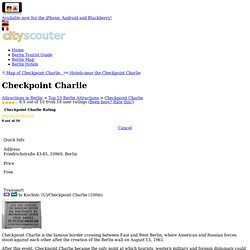
After this event, Checkpoint Charlie became the only point at which tourists, western military and foreign diplomats could cross into the communist state. The name "Checkpoint Charlie" came from the phonetic alphabet. There were two other American checkpoints - Helmstadt (Checkpoint Alpha) and Dreilinden (Checkpoint Bravo). Following this scheme, the third checkpoint on Friedrichstrasse was named "Checkpoint Charlie". Potsdamer Platz, Berlin Tourist Guide. Potsdamer Platz, destroyed during World War 2 and left desolate during the Cold War, is once again one of the central hubs of Berlin.
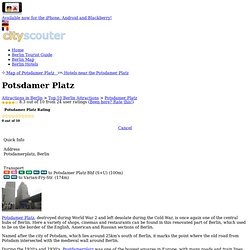
Here a variety of shops, cinemas and restaurants can be found in this renovated part of Berlin, which used to lie on the border of the English, American and Russian sections of Berlin. Holocaust Memorial, Berlin Travel Guide. The Holocaust memorial is dedicated to the memory of the thousands of Jews murdered by the Third Reich prior to and during World War II.
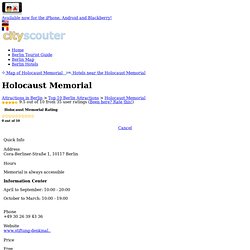
It took over a year to complete and was opened in December 2004. It is located close to the Brandenburg Gate and not far from the bunker where Hitler committed suicide. The memorial was designed by Peter Eisenman and consists of austere rectangular grey blocks, void of any decoration. The 19,000 square meter site is not level and the blocks also vary in height, ranging from 0.2m to 4.8 meters.
Except for their dimensions, all blocks are identical. East Side Gallery, Berlin Visitors Guide. Reichstag, Berlin Travel Guide. The impressive neo-renaissance Reichstag building, located in Berlin, was completed in 1894 and is today the seat of the German government.

It was designed by architect Paul Wallot to be the house of the first German Parliament and remained in use until 1933. It was here in 1918 that the German Republic was announced and since then it has been host to many key political historical events. Unfortunately, in 1933, it is thought that a disgruntled Dutch communist deliberately set the building on fire, though there is still a lot of controversy surrounding the actual series of events.
Many thought the fire had been deliberately started by the Nazis in order to bolster public support and give more power to Adolf Hitler's National Socialist Party. As a result, the Reichstag was extensively damaged. Pergamon Museum, Berlin City Guide. The Pergamon Museum is one of the largest and most impressive museums in Berlin, and if you only get to see one museum, this should be it.
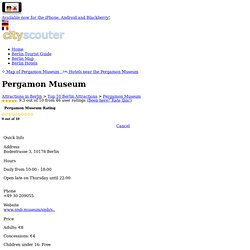
Itwas named after an ancient Greek city and was eventually opened in 1930 after a long period of construction. Building had started in 1907 but was severely interrupted due to World War I and the subsequent years of economic hardship in Germany. Like so many other notable Berlin museums, it is located on Museum Island and is listed as a UNESCO world heritage site. The museum was partially destroyed in World War II but most of its collection had been moved to more secure areas and some of the bigger pieces were walled in for protection, therefore the majority of the artifacts did not get damaged. Brandenburg Gate (Brandenburger Tor), Berlin City Guide. The Brandenburg Gate is the last remaining gate that in medieval times, would have been used to enter the city.
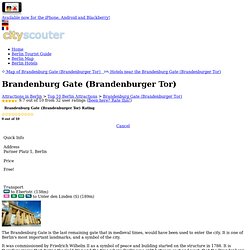
It is one of Berlin's most important landmarks, and a symbol of the city. It was commissioned by Friedrich Wilhelm II as a symbol of peace and building started on the structure in 1788. It is therefore ironic that during the Cold War and the time where Berlin was split between east and west, that the Brandenberg Gate sat in no mans land between the two states. On top of the gate, is a Quadriga - a four-horse chariot that in Roman times were a symbol of triumph.
After the Prussian defeat of 1806, Napoleon took the Quadriga to Paris where it stayed for almost ten years until Napoleon's defeat after which it was returned to Germany. The Nazi's also used the Brandenburg Gate as a symbol of their power. KaDeWe. KaDeWe in Berlin (photo: Berlin.de / Tobias Kneschke) more photos Historic pictures of KaDeWe Berlin’s most famous trademark department store is KaDeWe (Kaufhaus des Westens) – or department store of the West.

It is Berlin’s shopping paradise, a favourite, easy to spot landmark on Wittenberg Platz.